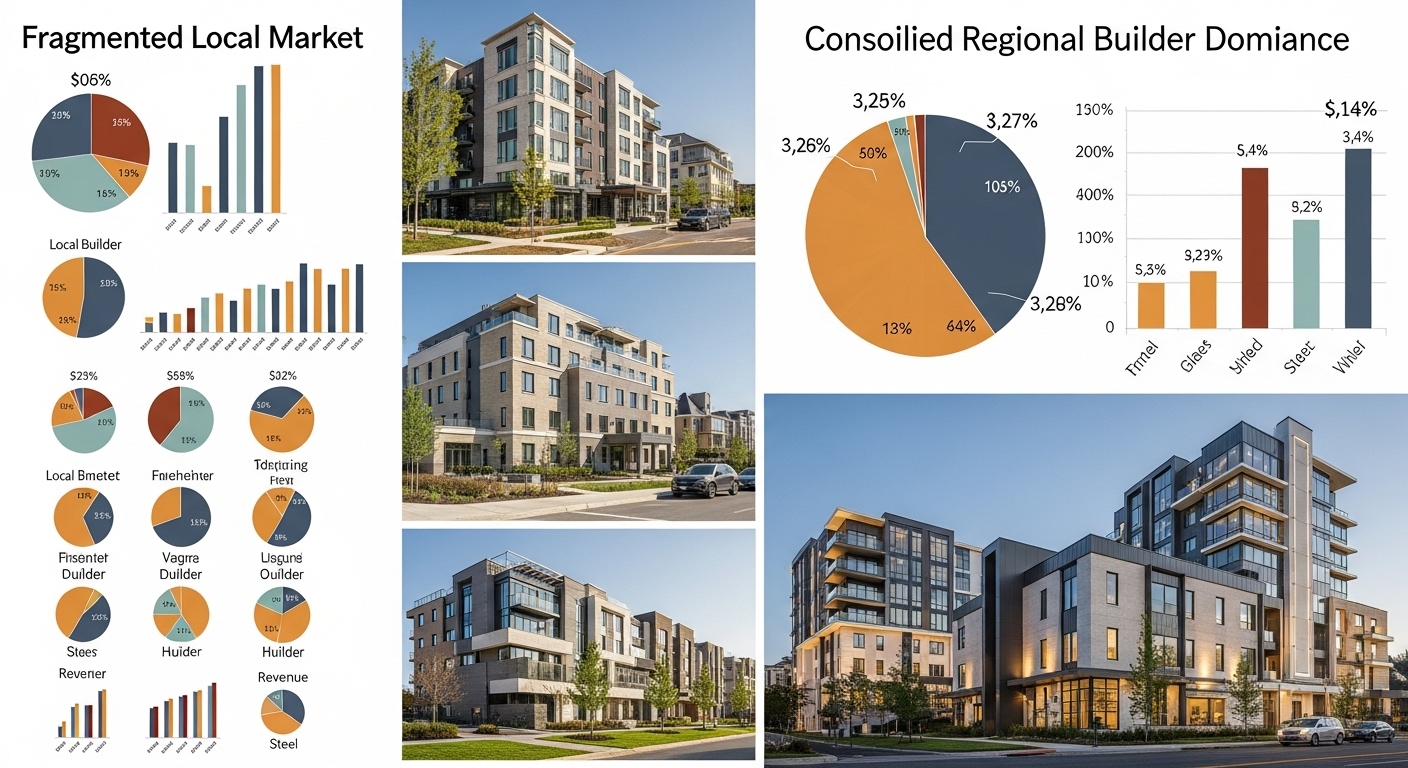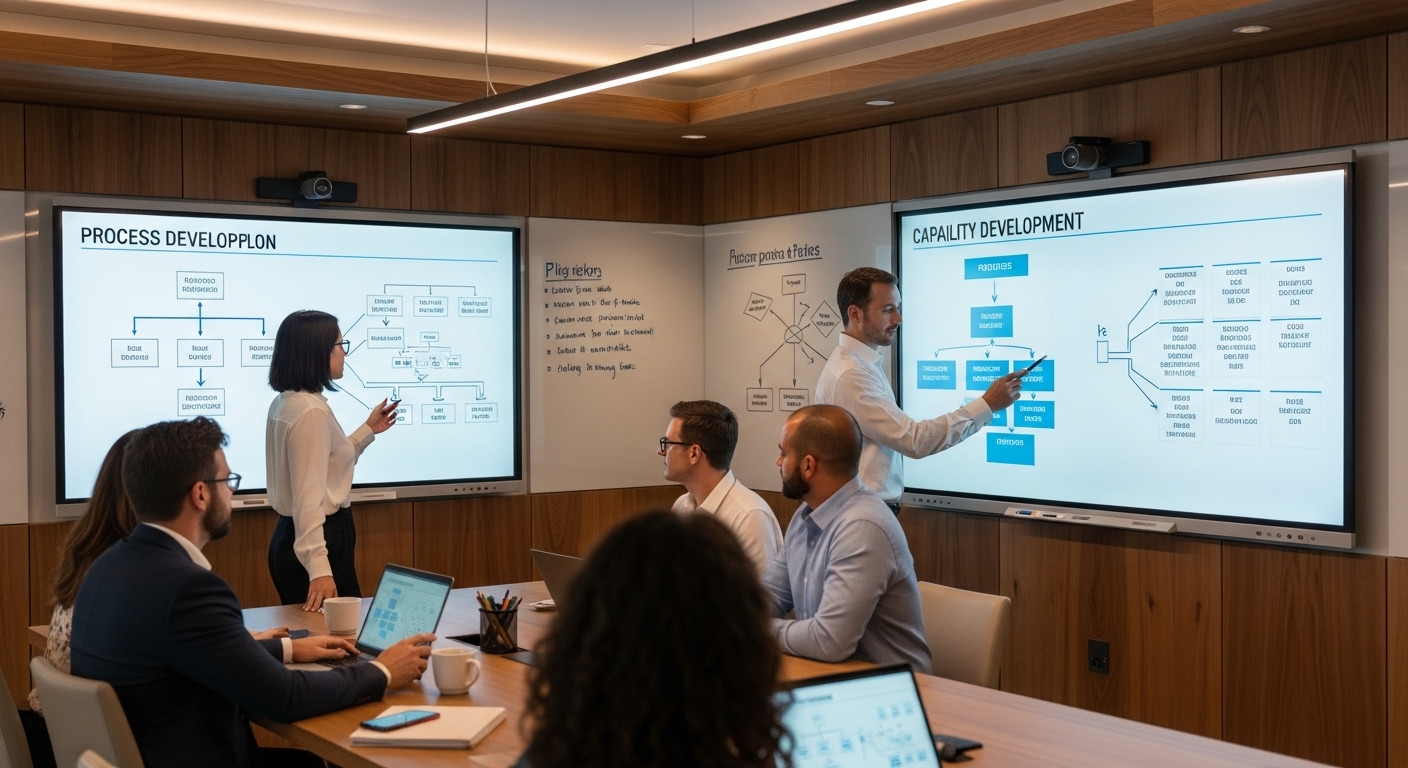August 22, 2025 by 100XBuilds Team
Acquisition Strategy Guide: Growing Through Strategic Purchases

"We acquired three regional builders in 18 months and increased our annual revenue from $12M to $47M while maintaining 23% gross margins." - Regional Builder CEO
The luxury home building industry is consolidating rapidly. While smaller builders struggle with rising costs and labor shortages, strategic acquirers are capturing market share at unprecedented rates. Mid-market builders who master the acquisition playbook are growing 3-5x faster than organic-only competitors.
The data tells a compelling story: builders executing strategic acquisitions report average revenue growth of 340% over three years, compared to 45% for organic-only growth strategies. More importantly, acquired revenue typically converts at higher margins due to operational synergies and enhanced market positioning.
The Strategic Acquisition Imperative
Market dynamics have created a perfect storm for acquisition opportunities. Over 2,400 residential builders with $1M+ revenue are actively seeking exit strategies, driven by succession planning, capital constraints, and operational complexity.
For mid-market builders ($5M-$50M annual revenue), strategic acquisitions offer multiple competitive advantages:
Market consolidation acceleration: Acquire established customer bases and eliminate competition simultaneously
Operational leverage: Spread fixed costs across larger revenue base, improving margins by 8-15%
Talent acquisition: Secure experienced teams in tight labor markets
Geographic expansion: Enter new markets with established relationships and local expertise

The most successful acquirers follow a systematic framework that identifies, evaluates, and integrates targets while maintaining operational excellence throughout the process.
Target Identification Framework
Strategic acquisition success begins with disciplined target identification. The highest-performing acquirers maintain active pipelines of 15-20 potential targets across multiple acquisition categories.
Primary Target Categories
Distressed assets: Builders facing cash flow challenges or succession issues, typically available at 0.3-0.6x revenue multiples
Strategic complements: Companies with complementary capabilities, customer segments, or geographic presence
Talent acquisitions: Smaller builders with exceptional teams or specialized expertise
Land portfolio plays: Builders with valuable land positions or development rights
Market Intelligence Systems
Successful acquirers develop systematic market intelligence capabilities:
Financial monitoring: Track building permit data, lien filings, and payment patterns to identify distressed situations
Relationship mapping: Maintain connections with attorneys, accountants, and industry professionals who advise potential sellers
Competitive analysis: Monitor competitor performance, leadership changes, and strategic challenges
Succession planning intelligence: Identify aging ownership groups without clear succession plans

The most effective target identification combines systematic market scanning with relationship-driven deal flow. Acquirers sourcing 60%+ of deals through relationships achieve 23% higher returns compared to auction-driven acquisitions.
Financial Evaluation Methodology
Rigorous financial evaluation separates successful acquisitions from value-destroying deals. The luxury building market requires specialized valuation approaches that account for project-based revenue, land inventory, and customer relationship value.
Core Valuation Metrics
Revenue multiple analysis: Luxury builders typically trade at 0.8-1.4x annual revenue, depending on market position and growth trajectory
EBITDA multiples: Established builders with consistent profitability command 4-7x EBITDA multiples
Asset-based valuation: Land inventory, work-in-progress, and equipment values provide downside protection
Customer lifetime value: Repeat customers and referral networks add 15-25% premium to base valuations
Due Diligence Framework
Comprehensive due diligence prevents costly acquisition mistakes:
Financial verification: Three years of audited financials, job costing accuracy, and cash flow analysis
Legal compliance: Licensing, insurance, warranty obligations, and litigation exposure
Operational assessment: Project management systems, quality control processes, and vendor relationships
Market position: Customer satisfaction scores, brand recognition, and competitive differentiation

Pro tip: The most successful acquirers complete preliminary due diligence before formal negotiations begin, identifying deal-breakers early and accelerating closing timelines.
Hidden Value Identification
Experienced acquirers identify value creation opportunities that sellers often overlook:
Operational improvements: Streamlined processes can improve margins by 12-18% within 12 months
Technology integration: Modern project management and customer systems increase efficiency and customer satisfaction
Vendor consolidation: Combined purchasing power reduces material costs by 8-12%
Cross-selling opportunities: Expanded service offerings to existing customer base
Deal Structure Optimization
Strategic deal structuring balances risk mitigation with seller motivation while preserving value creation opportunities. The most successful acquisitions use creative structures that align interests and minimize integration risk.
Payment Structure Options
Cash transactions: Fastest closing, highest seller appeal, requires significant capital
Seller financing: Reduces upfront capital requirements, maintains seller commitment to transition success
Earnout provisions: Links final purchase price to performance targets, sharing integration risk
Equity participation: Retains key personnel and aligns long-term interests
Risk Mitigation Strategies
Escrow arrangements: Hold back 10-20% of purchase price for warranty and representation coverage
Key person retention: Employment agreements and incentive packages for critical personnel
Customer retention guarantees: Earnout provisions tied to customer and revenue retention metrics
Operational milestone payments: Staged payments based on integration success metrics

The optimal deal structure varies by target characteristics and strategic objectives. Distressed acquisitions favor cash transactions with significant discounts, while strategic acquisitions often benefit from earnout structures that motivate seller cooperation.
Integration Excellence Framework
Post-acquisition integration determines long-term success. Acquirers with structured integration processes achieve 89% of projected synergies, compared to 34% for ad-hoc approaches.
First 100 Days Priorities
Leadership alignment: Establish clear reporting relationships and decision-making authority
System integration: Merge critical systems while maintaining operational continuity
Customer communication: Proactive outreach to maintain relationships and prevent defections
Team integration: Cultural alignment and retention of key personnel
Operational Synergy Realization
Procurement consolidation: Leverage combined volume for better pricing and terms
Process standardization: Implement best practices across combined organization
Technology optimization: Eliminate redundant systems and upgrade capabilities
Quality system integration: Maintain high standards while improving efficiency
Cultural Integration Strategies
Communication cadence: Weekly updates during first quarter, monthly thereafter
Success celebrations: Recognize achievements and milestones throughout integration
Training programs: Cross-train teams on combined processes and standards
Feedback mechanisms: Regular surveys and feedback sessions to address concerns

Critical insight: The most successful integrations maintain acquired company strengths while implementing acquirer best practices. Forced cultural changes reduce retention rates by 40% and delay synergy realization.
Market Expansion Through Acquisition
Strategic acquisitions enable rapid geographic expansion with established market presence and local expertise. Builders entering new markets through acquisition achieve profitability 18 months faster than greenfield expansion strategies.
Geographic Expansion Framework
Market selection criteria: Population growth, income levels, regulatory environment, and competitive landscape
Local partnership value: Established relationships with suppliers, subcontractors, and regulatory authorities
Brand positioning: Maintain local brand equity while leveraging corporate capabilities
Operational scaling: Replicate successful processes while adapting to local market conditions
Competitive Positioning Benefits
Market share consolidation: Eliminate competition while acquiring customer base
Pricing power enhancement: Reduced competition enables premium positioning
Supplier relationship leverage: Combined volume improves terms and priority status
Talent market dominance: Attract top performers from consolidated competitor base
Technology and Systems Integration
Modern acquisition success requires sophisticated technology integration that maintains operational continuity while capturing efficiency gains. Builders with integrated technology platforms report 23% higher customer satisfaction scores and 15% improved project margins.
System Integration Priorities
Project management platforms: Unified scheduling, budgeting, and communication systems
Customer relationship management: Integrated lead tracking, sales processes, and customer service
Financial systems: Combined accounting, job costing, and reporting capabilities
Document management: Centralized plans, permits, and project documentation
Data Integration Strategies
Customer data consolidation: Unified customer profiles and interaction history
Project performance analytics: Combined metrics for benchmarking and improvement
Financial reporting integration: Consolidated reporting with segment visibility
Operational metrics tracking: Standardized KPIs across all locations and teams

Implementation tip: Successful technology integration follows a phased approach, prioritizing customer-facing systems first to maintain service levels during transition periods.
Financial Performance Optimization
Strategic acquisitions create multiple opportunities for financial performance improvement beyond simple revenue addition. The most successful acquirers achieve 25-35% EBITDA improvement within 24 months through systematic optimization.
Margin Enhancement Strategies
Overhead allocation optimization: Spread fixed costs across larger revenue base
Vendor consolidation benefits: Negotiate better terms with increased volume
Process efficiency gains: Eliminate redundancies and implement best practices
Premium positioning opportunities: Enhanced capabilities command higher prices
Working Capital Management
Inventory optimization: Reduce carrying costs through better forecasting and coordination
Accounts receivable acceleration: Implement best-in-class collection processes
Supplier payment optimization: Negotiate extended terms while maintaining relationships
Cash flow forecasting: Improved visibility enables better capital allocation decisions
Capital Allocation Framework
Growth investment priorities: Focus capital on highest-return opportunities
Debt optimization: Refinance at combined entity scale for better terms
Dividend policy alignment: Balance growth investment with shareholder returns
Acquisition funding strategy: Maintain capacity for additional strategic opportunities
Risk Management and Mitigation
Acquisition risk management requires comprehensive planning and systematic execution. Builders with formal risk management frameworks experience 67% fewer integration challenges and achieve target synergies 6 months faster.
Pre-Acquisition Risk Assessment
Market risk evaluation: Economic sensitivity, competitive threats, and regulatory changes
Operational risk analysis: Key person dependencies, system vulnerabilities, and process gaps
Financial risk assessment: Cash flow volatility, debt capacity, and working capital requirements
Legal and compliance review: Litigation exposure, regulatory compliance, and warranty obligations
Integration Risk Mitigation
Communication planning: Proactive stakeholder communication prevents rumors and uncertainty
Retention strategies: Secure key personnel through incentives and career development
Customer relationship protection: Maintain service levels and relationship continuity
Operational continuity planning: Backup systems and processes prevent disruption

Risk management insight: The highest-performing acquirers treat risk management as a competitive advantage, using superior planning and execution to capture opportunities that others avoid.
Performance Measurement and Optimization
Systematic performance measurement enables continuous improvement and validates acquisition success. Acquirers tracking comprehensive metrics achieve 43% better long-term returns compared to those focusing solely on financial outcomes.
Key Performance Indicators
Financial metrics: Revenue growth, margin improvement, ROIC, and cash flow generation
Operational indicators: Customer satisfaction, project delivery times, and quality scores
Integration progress: Synergy realization, system integration, and cultural alignment
Market position: Market share, competitive wins, and brand recognition
Reporting and Analytics Framework
Monthly performance dashboards: Real-time visibility into key metrics and trends
Quarterly business reviews: Comprehensive analysis of performance versus targets
Annual strategic assessments: Long-term value creation and strategic positioning
Benchmarking analysis: Performance comparison with industry standards and competitors
Continuous Improvement Process
Best practice identification: Capture and replicate successful strategies across organization
Process optimization: Systematic improvement of integrated operations
Technology enhancement: Ongoing system upgrades and capability additions
Strategic planning updates: Regular reassessment of acquisition strategy and targets
Building Your Acquisition Capability
Developing systematic acquisition capability requires dedicated resources and specialized expertise. Builders with formal acquisition teams complete 3x more transactions and achieve 28% higher returns than occasional acquirers.
Organizational Requirements
Dedicated acquisition team: Business development, financial analysis, and integration specialists
Advisory relationships: Investment bankers, attorneys, and industry consultants
Capital access: Pre-arranged financing for rapid transaction execution
Integration capabilities: Project management and change management expertise
Process Development
Target identification systems: Systematic market scanning and relationship development
Evaluation frameworks: Standardized due diligence and valuation processes
Integration playbooks: Proven methodologies for successful combination
Performance tracking: Comprehensive measurement and optimization systems

Success factor: The most effective acquisition programs balance systematic processes with entrepreneurial flexibility, enabling rapid response to market opportunities while maintaining disciplined evaluation standards.
Strategic acquisition represents the fastest path to market leadership for ambitious luxury builders. The consolidating market creates unprecedented opportunities for well-capitalized builders with systematic acquisition capabilities.
The window for acquisition-driven growth is narrowing as competition for quality targets intensifies. Builders who develop acquisition capabilities now will dominate their markets for the next decade.
Ready to accelerate your growth through strategic acquisitions? Contact 100XBuilds today to develop your acquisition strategy and capture market-leading opportunities before your competitors do. Our proven framework has helped luxury builders achieve 340% revenue growth through strategic acquisitions.
